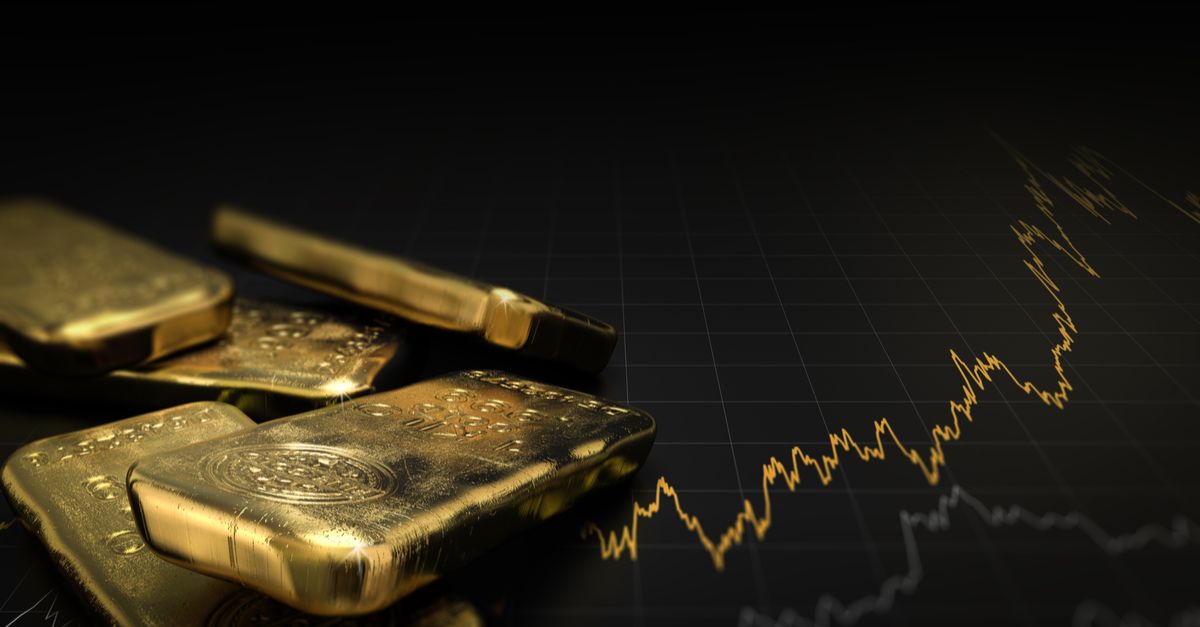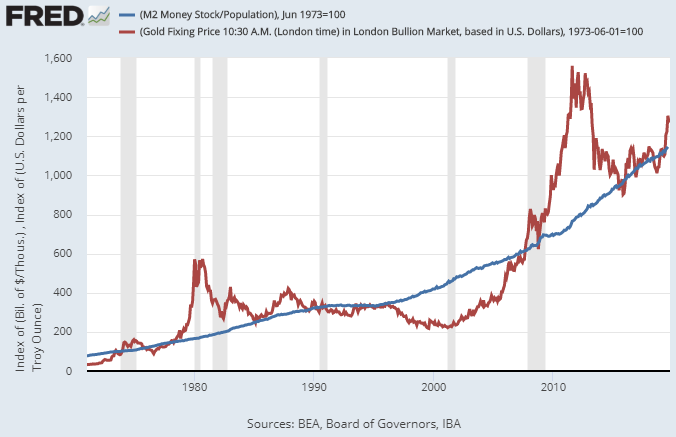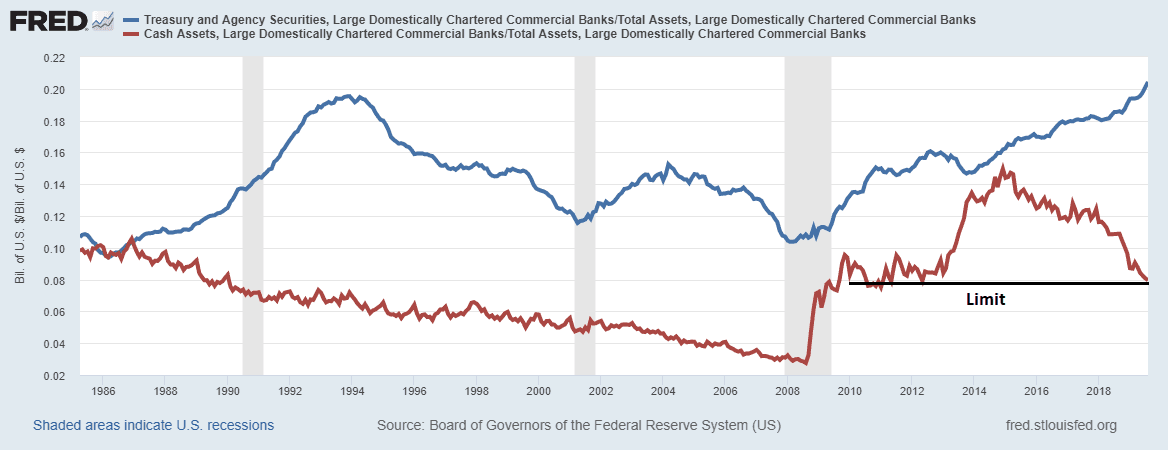Gold Price Forecast: The Path To New All-Time Highs

I’m not a perma-bull on gold, and I invest in a variety of asset classes depending on where value is in the market.
For example, I sold my gold and silver coin collection at high levels in 2011 because there was so much enthusiasm in the space and started buying back in 2018 with a long-term bullish outlook when gold touched $1,200. After an initial large investment in 2018, I’ve been dollar-cost averaging into gold and golds stocks over the past year.
Although we may have pullbacks along the way, and gold may retest its previous resistance level in the high $1,300’s as support at some point, my base case is for gold to reach or at least test new all-time highs in dollar terms as the rest of this business cycle plays out into the early half of the 2020’s decade.
How I Value Gold
Gold is challenging to value because it doesn’t produce cash flows, so discounted cash flow analysis and other valuation methods are out the window. I treat it as a currency, but I cannot use most of the same metrics that I value other currencies with (such as foreign-exchange reserve levels, current account balances, purchasing power parity vs exchange rates, and so forth).
Therefore, I use a combination of two primary methods to value gold, along with a set of secondary metrics for confirmation.
Valuation Method One: Gold vs Money Supply
For the first method, I track the price of gold relative to the growth of U.S. broad money supply per capita over the long run. According to the World Gold Council, there have likely been about 190,000 metric tons mined in human history, and most should still be around. This comes out to approximately 6.7 billion ounces, which is slightly less than one ounce per person in the world. This is a very rough estimate and the exact number is not important.
Gold production increases the total estimated gold supply by 1-1.5% per year, which is roughly in line with human population growth. So, the amount of gold per person stays relatively stable over time, and new gold production gets increasingly more expensive as easy deposits are mined out. In contrast, the number of U.S. dollars per person increases substantially over time, so we would expect to see dollars devalue relative to gold over the long-term at a pace roughly equal to that differential.
This chart, for example, shows the per-capita broad money supply of the United States (blue line) relative to the price of an ounce of gold (red line), indexed to 100 in 1973:
Chart Source: St. Louis Fed
This is not a perfect measure, but it gives a ballpark estimate of how the price of gold has appreciated relative to the amount of dollars per person, and is in my opinion a good way to think about the appropriate growth rate of the price of gold over time. I became interested in gold again once it came back down from its 2011 peak and started trending with the growth of money supply again during the 2015-2018 period.
There are various starting points that investors may find suitable for their own analysis. I use 1973 as my baseline because that allowed enough time after the 1971 decoupling from the dollar for the market to determine a free-floating value for gold, and then starts the comparison from there. I also like to use 1995 as a starting point (which gives similar results) because that was a stable period, prior to any of the recent stock or real estate bubbles, and serves as a nice baseline from about two and a half decades ago.
However, we can see from the chart that although the price of gold has generally tracked the trend of per capita growth of money supply, there were periods where the price went far above the trend, and a rare period in the late 1990’s and into the early 2000’s where it went below the trend.
These periods above and below the trend are explainable by my second primary valuation method: real interest rates.
Valuation Method Two: Real Interest Rates
This next chart shows the real inflation-adjusted yield on the 10-year U.S. treasury note (blue line) compared to the year-over-year percentage change in the price of gold (red line):
Chart Source: St. Louis Fed
There is a significant inverse correlation between real interest rates and the year-over-year percent price change in gold. When real interest rates are low or negative, gold usually does quite well.
Whenever fiat money is stable and you can earn a positive real return on your purchasing power by sticking your money into a bank or into safe bonds, there is a big opportunity cost against holding gold, which produces no cash flows and has a storage cost. Therefore, gold demand decreases. This is exactly what we saw from the late 1980’s to the early 2000’s when the price of gold was depressed for decades. Real interest rates were high and economic growth was strong, so the incentive to hold gold was low.
On the other hand, whenever bonds and banks pay low or negative real returns, the opportunity cost to hold gold decreases, and it makes more sense to hold real tangible money in the form of precious metals. Therefore, gold tends to do well in low/negative real rate environments, and may go above the long-term trend line of money supply growth per capita, under these conditions.
In addition, 1980 saw a period of high inflation and 2011 saw novel quantitative easing monetary policies, and both of these events caused a lack of confidence in the dollar resulting in gold briefly spiking far higher than the trend line. These spikes in the gold price were essentially anticipations that money supply would explode higher and dollars would be worth far less, but those concerns did not come to pass at those times, so gold prices came back down to the trend.
Two Methods Combined
To summarize these two valuation methods, the amount of gold per person is relatively fixed over time while the number of dollars per person increases over time, so the price of gold logically and historically appreciates in dollar terms roughly at the pace of dollar-creation per capita. Periods of high real interest rates can temporarily suppress the gold price below this trend line, and periods of low real interest rates (and particularly during concerns about the stability of the dollar itself) can temporarily boost the price of gold above this trend line.
These are not perfect measures, and there are a variety of alternative starting points or calculation methods along this line of thought, but having a process and a framework helps investors avoid major mistakes and realize major opportunities.
Other Valuation Metrics
Other metrics I look at for confirmation or context include the price of gold compared to typical all-in sustaining costs to mine it at any particular moment, the price of gold relative to other real assets such as the median home price, a barrel of oil, or a stake in the Dow Jones Industrial Average, and lastly, a sentiment reading on how the broad market feels about gold and whether the investing public seems to be interested in the metal or not.
My overall view is that gold is moderately-valued or a bit richly-valued at the moment, but that it is deserving of a premium as interest rates around the world are low or negative.
In other words, gold is not overvalued, nor is it a clear bargain. It is above the broad money supply trend line, but only slightly. It is profitable to mine, but not excessively profitable. It is moderately valued compared to equities and median home prices relative to historical norms, and closer to peak value against its historical relationship with oil and copper. There is renewed interest in the precious metal space by precious metal enthusiasts and central banks, but it is still largely dismissed by generalist investors. Compared to gold, silver is a better bargain by all of these metrics for investors that can withstand the higher volatility.
The Path to New Highs for Gold
Since I initiated my long position in gold and gold stocks in 2018 (and silver a bit sooner than that), the price of gold has increased substantially and is now mildly above the trend line of money supply per capita.
I remain long gold and gold stocks, however, because real interest rates continue to decrease and the Federal Reserve is now in a phase of cutting interest rates. Bond yields throughout much of Europe and Japan are negative. U.S. equities are also historically expensive based on a variety of metrics. In this environment, I would expect gold to trade above its trend line as it is now, and it continues to be very much worth holding as part of a diversified portfolio, in my view.
Gold prices have reached new highs recently in most currencies around the world, but still remain significantly below its 2011 highs in dollar terms. The dollar tends to have approximate 15-year cycles of strength and weakness relative to a basket of other major currencies, and we’re currently in one of those periods of dollar strength. This chart shows the value of the dollar compared to a basket of major currencies:
Chart: St. Louis Fed
If the dollar were to return to where it was in 2014 relative to other currencies, it would be about a 20% devaluation from current levels. If gold were to stay valued roughly where it is compared to other currencies while the dollar weakens, then we’d be looking at a 20% gain in the price of gold in dollar terms, which brings us up to $1,800 gold. Add in a little time, more rate cuts, and some quantitative easing by the Fed, and new highs are likely in sight.
The Case for a Weaker Dollar
My base case indeed is for the U.S. dollar to likely weaken against many other currencies over the coming years. The strong dollar period of 2015-2019 has been characterized by large fiscal deficit stimulus combined with tight monetary policy (compared to the rest of the developed world), which is a temporary recipe for a very strong dollar, but now U.S. monetary policy is being forced to shift dovish to fund those large U.S. deficits.
Whenever the dollar is strong, foreign sources generally don’t buy U.S. treasuries at scale, meaning that the U.S. needs to fund its own deficit. Ever since the dollar became strong in late 2014, foreign sources (green line in the chart below) significantly slowed their buying of U.S. treasuries, which forced domestic sources (blue line below, mainly banks, insurers, corporations, and pensions) to buy $3 trillion in U.S. debt over a five year period:
Chart Source: St. Louis Fed
However, as the overnight repo rate spike showed in September, U.S. banks have run dry on liquidity to keep buying U.S. treasuries. There is no more excess liquidity in the U.S. banking system after five years of depleting it via converting cash into T-bills to fund the government deficit.
When the Fed performed the third round of quantitative easing (QE) back in 2014, it filled large U.S. banks with plenty of excess cash, and when this round of QE came to an end and the firehose of dollar liquidity ceased, the dollar strengthened and as previously described, foreigners largely stopped buying U.S. debt.
Over the past five years since then, large U.S. banks have drawn down their cash levels (red line in the chart below) from 15% to 8% of total assets, and have increased their treasury holdings from 15% of total assets to an all-time record high of 21% of total assets (blue line below). Their cash levels have now come down to post-crisis bank regulatory limits and can’t really go lower under the current framework, meaning they are out of ammo to buy more treasuries:
Chart Source: St. Louis Fed
The Federal Reserve has responded to this problem by expanding its balance sheet since the day of the repo spike, to take treasuries and inject liquidity back into the banking system. The Fed is now monetizing U.S. debts, essentially, and has increased its balance sheet by $175 billion in the past three weeks:
Chart Source: St. Louis Fed
Technically this leg up in the balance sheet is temporary, because it consists of a combination of overnight loans and 2-week loans. However, these loans keep being rolled, and it is unlikely to be unwound. There’s a high probability that this turns into another round of permanent balance sheet expansion.
With $100 billion or more in U.S. net debt growth per month that the banking system doesn’t have any room on their balance sheets to buy, the Fed’s continued balance sheet expansion shows no signs of stopping as long as the dollar remains at elevated levels causing foreigners not to buy treasuries at scale.
In other words, dollar strength is its own self-correcting mechanism until it forces itself to be weaker. While anything is possible, many analysts that expect the dollar to continue far higher seem to underestimate how much damage a strong dollar does to the U.S. economy and the funding situation for U.S. treasuries, including increasing the risk of a recession. As of three weeks ago, the Fed has been forced to inject major and ongoing liquidity into the system, which historically tends to weaken the dollar over time, or at least prevent it from strengthening.
Final Thoughts
Evidence suggests that we’ll see a significantly different monetary framework over the next five years compared to the past five years, with 2019 being the inflection point. In particular, we’re currently witnessing a shift from years of relatively tight U.S. monetary policy to loose U.S. monetary policy at a time when the dollar is very strong.
While nothing is for certain, I expect gold to do well in dollar terms in the coming years with a solid probability of testing new all-time highs. At the very least, the risk/reward scenario for both gold and silver look attractive here for long-term investors. Downside price action is likely limited to the $1,300’s for gold, while upside potential has a large range of possible outcomes. I’m a continued buyer of dips at these levels as part of a diversified portfolio.
Lyn Alden provides a free newsletter at LynAlden.com covering equities, precious metals, and other investments.
********























